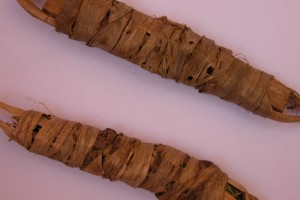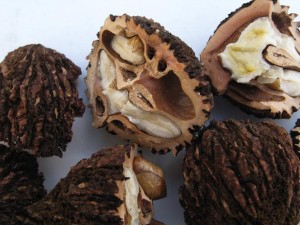Black walnuts (Juglans nigra) are the most widespread of all native nuts in the Eastern United States. The related pecan (Carya illinoensis) is more restricted and southern in its distribution but is widely planted throughout the south. Our native chestnut (Castanea dentata) has gone the way of rational political discourse and ten cent coffee. Our largest common nut, black walnut provides well-known resource for wood, nuts, and stain; and lesser-known products including syrup, cordials—even a kind of toothpaste. It is more than just nuts.
Nuts and Fruits
Tryma. That word is more than botany babble, it is the technical term for the specialized fruit of the walnut –so technical that I have yet to hear a botanist actually use it for the round, green fruits borne in late fall. The term—when used—signifies the distinct origin of the “husk” of the fruit because the husk is not derived from the flower; it is from bracts and associated structures at the base of the female flower.
While messy, it is easy to collect bushels of the fruits. However, removing the husk is tedious and staining. As a boy in southern Wisconsin where walnuts are common and frequently planted along country lanes, I would go with my parents to collect nuts. Unlike many trees, most walnuts seem to produce a suitable crop each year. After drying and turning jet black we put them in a gunny sack, placed the sack on our driveway, and my dad would drive over them several times with his Studebaker. The hard nuts were then easily separated from the chaff of the husk. Long winter nights in that part of the country were a good time to retrieve the delicious meat from the ironclad nuts. Figure One.
Figure One. Black walnuts harvested in southern Wisconsin in October. The hard, woody inner wall of the fruit makes extracting the delicious nutmeats a challenge.
Black walnut is my personal favorite nut because of its rich taste and distinctive odor. The use of black walnut in cooking and snacking are well known. But don’t limit these nutritious nuts to cakes. One way I enjoy them is by making black walnut chips. This involves coating a leaf with walnut paste. Sticking to wild plants, I suggest young basswood leaves when they are less than three inches long. Figure Two. The recipe is simple. Take one cup of black walnuts, water, salt to taste. Put the walnuts into a blender and add water until the consistency of hummus. Coat leaves with paste. Using a food dehydrator, dry for 12 or more hours. These chips can be frozen. I have also used sour dock (Rumex acetosella) which adds a nice tang.

Figure Two. Basswood (Tilia americana) leaves coated with walnut paste and dried.
A Syrian Treat
I worked as a botanist in Aleppo, Syria in happier days. It is, or tragically was, a gourmand’s paradise. One of the Aleppan delicacies is candied green walnuts made from the Persian walnut (which we call English walnut), Juglans regia. In the middle of the summer, before the stony wall of the nut hardens, the young green fruits are harvested and boiled in sugar syrup with added species such as cinnamon until they no longer float. These are traditionally served as a dessert or with coffee. To my knowledge, black walnut has not been used for this purpose but there is no reason to think that the process would not be the same.
Waffles and Walnut Syrup?
An acquaintance in Syracuse, New York (known as the salt city because of the once large industry of salt mining) produces syrup from several native trees including black walnut. In general appearance and taste, I would have a hard time distinguishing the black walnut syrup from maple syrup though I think I detect a hint of black walnut in the finish. Salt City Syrup’s Facebook page is: https://www.facebook.com/saltcitysyrup/ They also produce butternut (Juglans cinerea) syrup. See Figure Three, below.

Figure Three. Samples of black walnut and butternut syrup from Salt City Syrup who describe the black walnut syrup as having “an earthy robust flavor with layered undertones of strong caramelized sugars with a berry finish.”
A Walnut Toast
That’s right, a walnut toast– not toasted walnuts. Peter Schafran and I have been experimenting making aperitifs and cordials from native plants and have the goal of trying a preparation for as many of the native plants of the Eastern United States as possible. One that we happened upon is black walnut, which makes a delicious cordial. The cordial is made from the immature fruits, not from the seeds. This unusual drink is easy to prepare.
Collect the fruits as late in the season as possible but before the “husk” of the fruit becomes discolored or, as often happens, infested with insect larvae. Mid-September is the best time here in southeastern Virginia. Put ten fruits in a two-quart glass jar and add five cups of vodka. (To standardize our productions, we always use Smirnoff). Leave in a cool dark place for at least one year. I recently bottled some that had been in vodka for two years. To make the cordial, decant the black liquid so that any residue is left behind and add one cup simple syrup (1:1 sugar/water). I recommend storing in the refrigerator as some cordials develop an unsightly precipitate when left at room temperature.The taste is definitely walnutty but with a mild bitter after taste. This pairs well with a good Stilton cheese.
Some time after preparing our black walnut cordial, I was in Italy and found an Italian liqueur called Nocino. It is prepared from the Persian walnut but has a similar taste to the cordial that Peter and I made.
Floss Well with Walnut
Black walnut is often cited as a clear example of a tree exhibiting allelopathic properties, that is, through its chemical exudates it can inhibit the establishment of competing plants. I don’t know if that chemistry suggests a link, but the roots of walnut, in this case the Persian walnut, are used as a dentifrice in Morocco to clean teeth. Figure Four. After eating all the walnuts, eating the syrup, and ending with the walnut cordial, a good flossing is recommended.

Figure Four. Strips of walnut root bark (from J. regia) I purchased in the market in Marrakech, Morocco as a dentrifice.
(Walnut paste recipe is from Musselman and Wiggins, Quick Guide to Edible Plants)
Lytton John Musselman
Copyright 2015
30 November 2015

May 24, 2016 at 1:59 am
I would never thought walnut sap would be good for a syrup. That being said, what other species could serve for syrup? I often observe sapsucker holes in our various tree species and I suspect the sap contains enough sugar to make it worth while for both bird and insects that feed on the sap. And the sapsucker also has a chance for added protein and other nutrition eating insects stuck or found there on the neat hole lines around a tree. (You may pass along my email address if you wish).—Dan